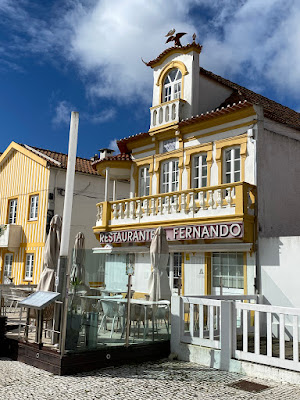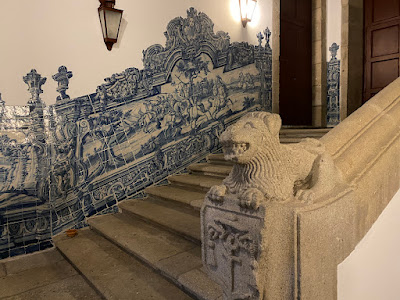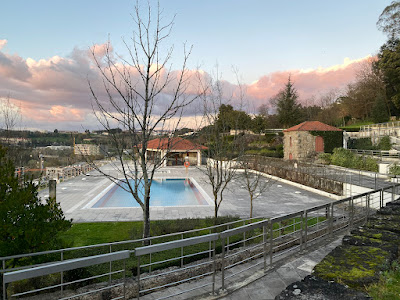PORTUGAL 2025
Douro Valley/Braga/Guimarães
Our initial plans were to drive and stay in the Douro Valley, but I'm not much of a wine drinker, so we decided to go North of Porto to the historic town of Braga... Plans change again. I found a very unique place to stay in a town nearby called Guimarães instead.
March 11
It was a very nice day as we headed towards the founding city of Portugal… Guimarães. Our first stop was in Costa Nova, a beach community just outside Aveiro.
Costa Nova, located near Aveiro, is a charming
fishing village known for its vibrant, colourful striped houses called "palheiros". These
houses, originally used for storing fishing equipment, are now popular tourist
destinations, along with its beautiful sandy beach
Guess I didn't need to put this description in a box ![]()


















Aveiro
Aveiro is a popular tourist destination, famed for its canals, nouveau architecture and colourful moliceiros boats. Sometimes referred to as the Venice of Portugal. We managed to find parking right beside the Praca da República (square of the republic).


Our first visit would be to the Igreja da Misericórdia de Aveiro.
Igreja da Misericórdia de Aveiro was originally started with the architectural vision of an Italian architect in 1585. However, the realization of this design only came to fruition in 1653, under the skilled guidance of a Portuguese master. The church's facade is adorned with 17th-century tiles and later baroque embellishments in limestone, the interior is decorated with19th century tiles.





The town is full of all kinds of quaint shops and buildings, all surrounding canals full of the colourful boats, almost like Venice, but with way less people.
















The hexagonal Capela de São Gonçalinho was built in 1714, in honor of Saint Goncalo (São Gonçalinho). The saint is popularly known among locals as a matchmaker saint who helps those seeking love partners. He was also recognized for his miraculous works on ailments relating to legs and feet. Of course it was closed, so we couldn't see inside.








Igreja de Nossa Senhora da Apresentação / Igreja Paroquial da Vera-Cruz aka The Church of Our Lady of the Presentation, commonly known as the Parish Church of the True Cross, began construction in 1606 and was completed in 1616.








The contrast in this city of historical and modern graffiti is odd, but nothing could prepare us for the Estação Ferroviária de Aveiro.
Estação Ferroviária de Aveiro (Aveiro railway station) was inaugurated in 1864, and in 1916 the new Aveiro station building was finished. The old building has a façade entirely decorated with tiles in blue and white tones, depicting various railway scenes, natural scenes and traditional culture and activities. The inside just looks like any old European train station.







Braga
Braga was our next stop, it is is touted as a great center of historical buildings, the first one to check out was Igreja Paroquial de Palmeira, it was closed. That's ok, it was finished in the late 1920's... way too new for my tastes.


The second stop was the Palácio da Dona Chica, The project was started in 1915, by a Swiss architect and the construction was suspended in 1919, it looks much older than that. The building has been sold and changed hands multiple times, currently owned by the city, nobody can agree on how much debt is owed and what its value is. We were not allowed to go there, and I got chased off by a guy on a tractor, when I stepped through the gate to take a picture.

That's when I decided to leave Braga and head straight to Guimarães, I'm glad we decided to stay somewhere else tonight, Braga is a very large and busy city..
Guimarães
Guimarães was settled in the 9th century, at which time it was called Vimaranes. Guimarães has a significant historical importance due to the role it played in the foundation of Portugal. The city is commonly referred to as the "birthplace of Portugal" or "the cradle city" (Cidade Berço in Portuguese) because it was in Guimarães that Portugal's first King, Afonso Henriques was born, and also because the Battle of São Mamede – which is considered the seminal event for the foundation of the Kingdom of Portugal – was fought in the vicinity of the city.
We found parking in Guimarães, and it was a short walk to the castle past the Capela de Santo António that is on the hospital grounds. There is three highlights in this area, a palace, a castle, and a Chapel.



The construction of Paço dos Duques de Bragança (the palace of the Dukes of Bragança),was begun in the early 15th century. Its design was inspired by that of the typical French manor houses, It was commissioned by the first duke of Bragança and the bastard son of the future king D. João I. Because the residence of the Dukes of Bragança was later moved to the Palace of Vila Viçosa, the building gradually fell into disrepair over the centuries until it was transformed into a military barracks in 1807. In 1937, restoration work was begun on the building and on 24 June 1959, exactly 831 years after the Battle of São Mamede, the palace was brought back to life in all its Norman-inspired Gothic glory.




















Castelo de Guimarães (Castle of Guimarães) is the principal medieval castle in the municipality of Guimarães. It was built in the 10th century to defend the nearby monastery from attacks by Moors and Norsemen.









At the top of the castle, along with the views is a V.R. setup room, which allows you to view a 360° recreation of the events and battle that resulted in the birth of Portugal. A lot of the scenes were shot inside this castle, and contained some of the worst acting and LARP fights I have seen since Elementary school.





The small church of São Miguel do Castelo was built in the 13th century. However, according to tradition, this church would have been built in the 12th century by Count Dom Henrique (Henry of Burgundy), where he would have baptised his son, the 1st King of Portugal Dom Afonso Henriques. Buried under the floor of this church are the great warriors of the nation’s founding period. The church became severely run-down during the early 19th century, but was later restored in 1874 and 1940. I'm not sure if they understand what "restored" means.


From the castle area, we walked into the main town square and the beautiful Garden known as Largo da República do Brasil.



Largo da República do Brasil, previously known as Campo de São Mamede or Field of São Mamede, holds a significant place in Portuguese history. It was on this field where the Battle of São Mamede took place in 1128. This battle marked an important turning point in establishing Portugal’s independence from the Kingdom of León. The square got its current name after Brazil declared independence from Portugal in 1822 to commemorate their shared historical ties.



Igreja e Oratórios de Nossa Senhora da Consolação e Santos Passos (Church of Our Lady of Consolation and Holy Steps) is one of the longest named churches in Portugal. The church's origins date back to a small chapel dedicated to Our Lady of Consolation, which was commissioned in March 1576. The new church was completed in October 1785, an example of baroque spatiality in Guimarães. Two towers were added to the front a century later, as well as the staircase and balustrade. During the 19th century, the Casa do Despacho and the Capela do Senhor dos Passos, attached to the church, were built.








We meet one of the most helpful caretakers of this church, as he wants us to see everything. It is 1€ to access the tower, and it uses a modern terminal to pay... no just dropping a coin in a can. He helps us as the first 2 cards we use to pay don't work, and he cheers as the 3rd card works. It's many steps to climb the tower, but the view back up the gardens was worth it.


It was such a nice day, we took advantage of the opportunity to have some pastries sitting on the patio overlooking the gardens.


I wanted to find some truly unique places to stay, so tonight we are staying in an old Monastery… Mosteiro de Santa Marinha da Costa
The origins of the Mosteiro de Santa Marinha da Costa
are steeped in legend and history. Believed to have been built upon a small 9th-century
temple, the site reveals traces of pre-Roman and Roman occupation. This sacred ground is
thought to have once been the residence of the counts of Portugal, with its church serving
as a palatine chapel. In the late 11th century, the site was transformed into a monastery,
initially under the care of the Augustinian canons. For over 350 years, they expanded the
church and constructed new cloisters, shaping the monastery into a center of spiritual and
intellectual life.
A devastating fire in 1951 left much of the structure in ruins, In 1972, the Portuguese
state acquired the property, initiating a comprehensive restoration. This project, which
won the National Architecture Prize in 1987, not only preserved the monastery's historical
essence but also adapted it into a pousada, offering modern comforts amidst its ancient
walls.







We walked around the building exploring hidden hallways and comfy spaces.













Behind the Monastery are these beautifully forested grounds. This is where we meet this adorable little cat, he took us on a guided tour of his property, alternating between leading us down trails, and following us as we explore.






The forest trails have these hidden little pockets that take you back in time. As the sun is dropping we are circled by little bats.






















The actual Cathedral is only open on Saturdays and special ocassions, but I was able to get some photos from inside.




Heading back inside the monastery, our little cat host wandered away, and we had an amazing dinner in their restaurant.




For such an old place, they had very comfy beds, and even if it was haunted, we had a great nights sleep.
March 12
We left Guimarães this morning and decided to give Braga one more chance, and stopped at the Bom Jesus Sanctuary before making our way to our last stop on mainland Portugal… Porto.
The Sanctuary of Bom Jesus do Monte (Good Jesus of the Mount) is a notable example of a Christian pilgrimage site with a monumental, Baroque stairway that climbs 116 meters (381 feet). Escadórios do Bom Jesus is the stairway leading to the church, it contains 17 landings adorned with symbolic fountains, allegoric statues and other Baroque style decoration along themes such as the Stations of the Cross, the Five Senses, the Virtues, Moses receiving the Commandments and, at the top, the eight biblical figures that contributed to the Condemnation of Jesus. To reach the Bom Jesus Sanctuary, you can go by foot up the staircase, drive your car the long way around or take the vertical tram (funicular), an impressive piece of 19th century engineering. This was the first of its kind to be installed in Portugal in 1882 and continues to use its water-powered system to power up the 300-metre slope in just 3 minutes.










One section of fountains is dedicated to the Five Senses (Sight, Smell, Hearing, Touch, Taste) each with it's own creepy fountain.











In 1629 a pilgrimage church was built dedicated to the Bom Jesus (Good Jesus), with six chapels dedicated to the Passion of Christ. . The new Baroque church Bom Jesus do Monte was built around 1725.




The level of detail on the altar is unlike any other church we have ever seen.













It's a long walk back down the stairs, because the funicular is closed (of course), but it's a very interesting walk. From Bom Jesus, it's a steady increase in traffic as we head into Porto to drop off our rental car.


